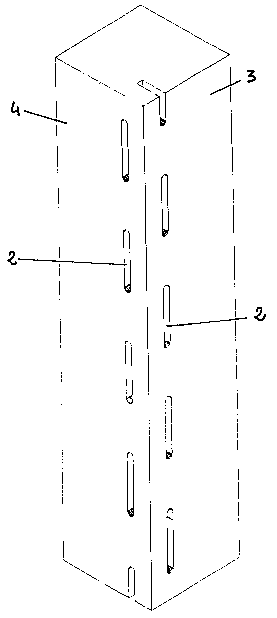Some of the information on this Web page has been provided by external sources. The Government of Canada is not responsible for the accuracy, reliability or currency of the information supplied by external sources. Users wishing to rely upon this information should consult directly with the source of the information. Content provided by external sources is not subject to official languages, privacy and accessibility requirements.
Any discrepancies in the text and image of the Claims and Abstract are due to differing posting times. Text of the Claims and Abstract are posted:
| (12) Patent Application: | (11) CA 2474647 |
|---|---|
| (54) English Title: | METHOD FOR THE CREATION OF CLEARANCE HOLES |
| (54) French Title: | PROCEDE POUR FACONNER DES TROUS DE DEGAGEMENT |
| Status: | Deemed Abandoned and Beyond the Period of Reinstatement - Pending Response to Notice of Disregarded Communication |
| (51) International Patent Classification (IPC): |
|
|---|---|
| (72) Inventors : |
|
| (73) Owners : |
|
| (71) Applicants : |
|
| (74) Agent: | RICHES, MCKENZIE & HERBERT LLP |
| (74) Associate agent: | |
| (45) Issued: | |
| (86) PCT Filing Date: | 2003-03-07 |
| (87) Open to Public Inspection: | 2003-10-02 |
| Examination requested: | 2008-02-22 |
| Availability of licence: | N/A |
| Dedicated to the Public: | N/A |
| (25) Language of filing: | English |
| Patent Cooperation Treaty (PCT): | Yes |
|---|---|
| (86) PCT Filing Number: | PCT/IT2003/000140 |
| (87) International Publication Number: | WO 2003079856 |
| (85) National Entry: | 2004-07-30 |
| (30) Application Priority Data: | ||||||
|---|---|---|---|---|---|---|
|
According to this invention, slots are made on the plane of any material; the
depth of these slots is equal to half the thickness of the plane, plus the
length of the radius of the stay bolt or stud to be entered, plus a tolerance
margin; the slots have the required length and are made on two or more sides
of the plane, in an alternate manner, so that the slot made on one side
overlaps by a few millimeters the slot made on the opposite side, creating in
such a way the space for the passage of a stay bolt and stud that serves as
the anchorage for the various pieces that make up to object to be realized.
L'invention concerne des trous de dégagement pouvant être façonnés à la surface d'un matériau quelconque. La profondeur de ces trous est égale à la moitié de l'épaisseur de la surface, plus la longueur du rayon du boulon ou du goujon à introduire, plus une marge de tolérance. Ces trous, d'une longueur donnée, sont façonnés en alternance sur deux côtés ou plus de ladite surface, de sorte que le trou disposé sur un côté chevauche de quelques millimètres le trou réalisé sur le côté opposé. Un espace est ainsi créé pour le passage d'un boulon ou d'un goujon servant d'ancrage à différents éléments constituant l'objet à réaliser.
Note: Claims are shown in the official language in which they were submitted.
Note: Descriptions are shown in the official language in which they were submitted.

2024-08-01:As part of the Next Generation Patents (NGP) transition, the Canadian Patents Database (CPD) now contains a more detailed Event History, which replicates the Event Log of our new back-office solution.
Please note that "Inactive:" events refers to events no longer in use in our new back-office solution.
For a clearer understanding of the status of the application/patent presented on this page, the site Disclaimer , as well as the definitions for Patent , Event History , Maintenance Fee and Payment History should be consulted.
| Description | Date |
|---|---|
| Application Not Reinstated by Deadline | 2012-03-07 |
| Time Limit for Reversal Expired | 2012-03-07 |
| Inactive: Abandoned - No reply to s.30(2) Rules requisition | 2011-04-07 |
| Deemed Abandoned - Failure to Respond to Maintenance Fee Notice | 2011-03-07 |
| Inactive: S.30(2) Rules - Examiner requisition | 2010-10-07 |
| Letter Sent | 2008-04-16 |
| All Requirements for Examination Determined Compliant | 2008-02-22 |
| Request for Examination Received | 2008-02-22 |
| Request for Examination Requirements Determined Compliant | 2008-02-22 |
| Inactive: Correspondence - Formalities | 2005-03-14 |
| Inactive: Cover page published | 2004-10-04 |
| Inactive: Notice - National entry - No RFE | 2004-09-30 |
| Inactive: Inventor deleted | 2004-09-30 |
| Application Received - PCT | 2004-08-26 |
| National Entry Requirements Determined Compliant | 2004-07-30 |
| Application Published (Open to Public Inspection) | 2003-10-02 |
| Abandonment Date | Reason | Reinstatement Date |
|---|---|---|
| 2011-03-07 |
The last payment was received on 2010-03-05
Note : If the full payment has not been received on or before the date indicated, a further fee may be required which may be one of the following
Please refer to the CIPO Patent Fees web page to see all current fee amounts.
| Fee Type | Anniversary Year | Due Date | Paid Date |
|---|---|---|---|
| Basic national fee - small | 2004-07-30 | ||
| MF (application, 2nd anniv.) - small | 02 | 2005-03-07 | 2004-07-30 |
| MF (application, 3rd anniv.) - small | 03 | 2006-03-07 | 2006-02-28 |
| 2006-02-28 | |||
| 2007-03-07 | |||
| MF (application, 4th anniv.) - small | 04 | 2007-03-07 | 2007-03-07 |
| Request for examination - standard | 2008-02-22 | ||
| MF (application, 5th anniv.) - standard | 05 | 2008-03-07 | 2008-02-29 |
| MF (application, 6th anniv.) - standard | 06 | 2009-03-09 | 2009-03-06 |
| MF (application, 7th anniv.) - standard | 07 | 2010-03-08 | 2010-03-05 |
Note: Records showing the ownership history in alphabetical order.
| Current Owners on Record |
|---|
| MASSIMO CRIACCI |
| Past Owners on Record |
|---|
| None |